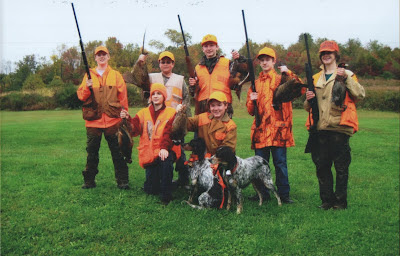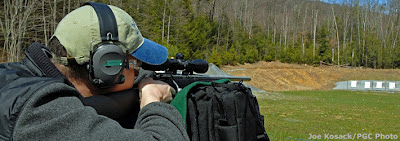Thanks to Marcellus Shale revenues, agency returns to pre-2005 pheasant
stocking level
HARRISBURG – Thanks to a series of Marcellus Shale leases
approved by the Board of Game Commissioners in 2011, Pennsylvania Game
Commission officials today announced that hunters will see the agency’s pheasant
stocking efforts increase to 200,000 birds for the upcoming small game seasons
for the first time since 2004.

The 110,090 males and 89,910 female pheasants
to be stocked this year includes 15,000 birds for the junior-only season (Oct.
6-13) and 1,500 pheasants allocated for those clubs sponsoring mentored
pheasant hunts for juniors on Oct. 6.
“Back in the 2004-05 fiscal
year, the Game Commission was forced to make many difficult financial decisions
as license revenues failed to keep pace with the increasing costs of doing
business,” Roe said. “While the agency’s last license fee increase took effect
in the 1999-2000 license year, many operational line-items, such as the price of
gasoline and other habitat improvement materials, increased at a faster
pace. The pheasant propagation program
was one budget item we were forced to cut, resulting in the closure of one game
farm and a 50 percent reduction in the pheasant production level from 200,000 to
100,000.
“During the intervening
years, we said that it would take another license fee increase for us to be able
to restore the cuts in pheasant production, as well as the other cuts that were
made, since reducing the pheasant program was saving the agency more than
$500,000 annually. However, thanks to
monies from recent Marcellus Shale-related gas leases on State Game Lands, we
have been able to return to the 200,000-bird level this year, which is
consistent with the Game Commission’s Strategic Plan and Pheasant Management
Plan.”
Going back to full production is a significant
accomplishment, according to Robert C. Boyd, Bureau of Wildlife Management
Wildlife Services Division chief, who oversees the pheasant propagation program.
“There were some very focused and concerted efforts that
went into getting the repairs and upgrades made to the game farm facilities,
particularly the two game farms in Lycoming County,” Boyd said. “The dedication
and perseverance was above and beyond commendable from the staff of the game
farms, the Bureau of Wildlife Habitat Management’s Engineering Division and the
Northcentral Region’s local land managers.”
Roe noted that the
pheasant stocking efforts will begin Oct. 5, when the agency will release 15,000
birds (7,580 males and 7,700 females) for the junior pheasant hunt scheduled for
Oct. 6-13. A listing of stocking
locations for the youth hunt can be found on pages 25-27 of the 2012-13
Pennsylvania Hunting and Trapping Digest, which is provided to each license
buyer.
Opening day of the
general pheasant hunting season is Oct. 20, and closes on Nov. 24. Pre-season stocking of pheasants will take
place in each region prior to Oct. 20, followed by four in-season stockings, as
well as a late season stocking.
Only male pheasants are
legal game in Wildlife Management Units (WMUs) 2A, 2C, 4C, 4E, 5A and 5B. Male and female pheasants are legal game in
all other WMUs.
During the regular fall
season, the agency focuses pheasant stocking on State Game Lands and select
state parks and federal lands. Birds
also are stocked on properties enrolled in the Game Commission’s Hunter Access
Program.
The Game Commission
has an updated publication titled “Pheasant Management Program,” which
identifies State Game Lands, and those state parks and federal lands with
suitable habitat that receive pheasant stockings. This publication can be found on the Game
Commission’s website (www.pgc.state.pa.us), and can be viewed by putting your
cursor over “Hunt/Trap” in the menu bar at the top of the page, clicking on
“Hunting,” clicking on “Pheasant” in the “Small Game” listing and then choosing “Pheasant
Management Program” in the “Programs” listing.
As part of the
agency’s Ring-necked Pheasant Management Plan, the Game Commission is taking
steps to restore self-sustaining and huntable populations of wild pheasants in
suitable habitats called “Wild Pheasant Recovery Areas” (WPRAs). For the 2012-13
seasons, WPRAs are defined as the Somerset, Central Susquehanna, Hegins-Gratz
Valley and Franklin County WPRAs.
To give these wild
pheasants the best opportunity to establish naturally reproducing populations,
the Board has banned the release of any artificially propagated pheasants,
including Game Commission-raised pheasants, in these areas, and pheasant
hunting is closed in these WPRAs. Also, to limit disturbances to nesting hen
pheasants, dog training of any manner and small game
hunting, except for groundhog, crows and waterfowl, will be prohibited in
these WPRAs from the
first Sunday in February through July 31 each
year.
“Working with major partners, such as Pheasants Forever,
the University of California and local landowners, we already have a jump start
on creating WPRAs,” said Carl G. Roe, Game Commission executive director. “These groups have invested in creating
pheasant habitat in four areas of the state. To make the best use of the
agency’s resources, and with the support of these partners, we have established
these areas as the first WPRAs in the
state.”
A regional breakdown for the
junior, regular and late season stockings are as follows: Northwest Region, 13,050 males and 25,380
females; Southwest Region, 29,010 males and 15,470 females; Northcentral Region,
6,980 males and 14,090 females; Southcentral Region, 19,020 and 9,920 females;
Northeast Region, 14,770 males and 16,910 females; and Southeast Region 27,260
males and 8,140 females. Regional
allocations are based on the amount of suitable pheasant habitat open to public
hunting and pheasant hunting pressure.
To offer hunters
better information about the stocking schedule, the Game Commission has posted
on its website charts for each of its six regions outlining the number of birds
to be stocked in each county, the public properties slated to be stocked and a
two- to three-day window in which stockings will take place within the
counties. To view the charts, go to the Game
Commission’s website (www.pgc.state.pa.us), put your cursor over
“Hunt/Trap” in the menu bar at the top of the page, click on “Hunting,” click on
“Pheasant” in the “Small Game” listing and then choose “Pheasant Allocation” and
click on the map for the county or region of interest.
Roe reminded hunters
that, several years ago, the agency enacted a regulation aimed at improving
safety for agency employees and vehicles involved in pheasant stocking.
“Each year, when Game Commission personnel are releasing
pheasants from the stocking trucks, employees and trucks are shot at by
unsuspecting hunters in the field. To
prevent this, the agency approved a regulation that prohibits hunters from
discharging a firearm within 150 yards of a Game Commission vehicle releasing
pheasants. As we provide better
information about when and where stockings will be conducted, we remind hunters
that they have an obligation to ensure that no stocking trucks or personnel are
in the vicinity.”
This
year, the late season is scheduled for Dec. 10-24 and Dec. 26-Feb. 2, for
Wildlife Management Units 1A, 1B, 2B, 2D, 2E, 2F, 2G, 3A, 3B, 3C, 3D, 4A, 4B,
4D, 5C and 5D. During the late season,
male and female pheasants are legal game in these WMUs. All other WMUs are closed during these
dates.
For details on the pheasant
seasons, please see pages 21-27 of the 2012-13 Digest. For more information about the clubs that
sponsor junior pheasant hunts, go to the Game Commission’s website (www.pgc.state.pa.us), put your cursor over “Hunt/Trap” in the menu bar at
the top of the page, click on “Hunting,” click on “Pheasant” in the “Small Game”
listing and then look under the “Junior Youth Pheasant Hunt”
category.
To augment the Game Commission’s pheasant stocking
program, Roe noted that each January sportsmen’s clubs are invited to enroll in
the agency’s “Pheasant Chick Program.” As part of the program, clubs are
required to erect appropriate facilities, purchase feed and cover other
expenses, and then they can receive, at no charge, pheasant chicks to raise and
release for hunting and dog training purposes on lands open to public hunting in
their local community.
“This is a wonderful opportunity for sportsmen to get
kids involved in raising pheasants and to learn more about wildlife and habitat
requirements,” Roe said. “Kids can be
involved in raising the birds, assist in developing habitat in their community,
and help release the pheasants into the wild.
Our game farm superintendents can assist sportsmen’s clubs by providing
technical advice and training to get a facility started.
“So, even as the Game Commission increases its stocking
efforts back to 200,000 and looks for ways to grow the program to 250,000 birds,
sportsmen’s clubs can be part of the solution by raising pheasants,
too.”
Also, Richard Palmer, Game
Commission Bureau of Wildlife Protection director, reminded hunters that an
executive order remains in effect that bans dog training on State Game Lands
from the Monday prior to the start of the youth pheasant season until the close
of the youth pheasant season, which, for this coming season, translates to Oct.
1-13. The order does not, in any manner, prohibit dog
handlers from using dogs as part of a junior-only pheasant hunt activity or for
dog training activities on any lands other than State Game Lands. He also noted that this order does not impact
dog training activities statewide during the remainder of the year, including
general small game seasons.
 Hunters who are successful in the upcoming deer hunting seasons are encouraged by the Pennsylvania Game Commission to consider participating in the state’s Hunters Sharing the Harvest (HSH) program, which channels donations of venison to local food banks, soup kitchens and needy families. Pennsylvania’s HSH program is recognized as one of the most successful among similar programs in about 40 states.
Hunters who are successful in the upcoming deer hunting seasons are encouraged by the Pennsylvania Game Commission to consider participating in the state’s Hunters Sharing the Harvest (HSH) program, which channels donations of venison to local food banks, soup kitchens and needy families. Pennsylvania’s HSH program is recognized as one of the most successful among similar programs in about 40 states.







